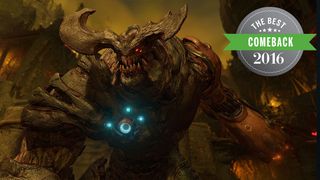
Doom is back with a vengeance. GOTY gongs are chosen by PC Gamer staff through voting and debate. We'll be posting an award a day leading to Christmas, along with personal picks from the PCG team. Keep up with all the awards so far here.
Samuel Roberts: I didn't expect Doom to be as surprising or inventive as it was. The exotic weapons mods managed to make the traditional Doom arsenal somehow feel pedestrian, and the way melee combat was woven into the pace of this brilliant campaign created tons of thrilling, tight encounters with enemies. The machine gun that you can mod into an automatic micromissile launcher is my favourite FPS weapon in years—by the end of the game you've essentially accumulated Tony Stark's armoury, and then some. The week off I spent playing this while drinking bottles of red wine was genuinely a highlight of 2016.
Tony Ellis: It took me a little while to warm to this. I was in a massively detailed, modern FPS environment, but I was whizzing around on 1993’s rollerskates. It was the UAC research facility, but it was also the generic iron-foundry-made-out-of-nuclear-submarines setting of every id Tech game ever. Then I hit my first Gore Nest and nothing else mattered. Doom is a game about moving forwards very fast through a continuous spray of meat fragments and bestial roars, and Doom 2016 delivers that brilliantly.
Chris Thursten: The singleplayer is a triumph because, unlike id's last attempt, they didn't try to extract Doom from the 90s: this formula dies when exposed to concepts like 'slowing down a bit' and 'irony'. This is an absurd power metal knee-slide of a thing, gloriously content to be metal as fuck when nobody else is even trying.
Phil Savage: I remember nu-Doom as brief bursts of frenetic, explosive combat, followed by long periods of wandering down seemingly innocuous corridors in the hope of uncovering a secret. It's become de rigeur to mock the linearity of 2010s-era FPS level design—a criticism that only really works if you pretend that all shooters are Call of Duty—but Doom's levels do have that nicely labyrinthine feel about them. For all the speed and fury of a arena fight against an army of demon pricks, Doom is also great at encouraging a more steady pace through exploration.
Doom is distilled, sincere joy that excels because of the focus on its most essential systems—and a healthy dose of self-awareness in place of superficial, flashy theatrics.
James Davenport: Reducing a room of demon spawn to mist in Doom has more in common with Tony Hawk’s Pro Skater than most modern shooters. Expression and style is as important as survival, and blowing the head off a Baron of Hell just before zipping up a dozen yards to rip a Cacodemon’s eye out is as satisfying as pulling off a 900 to a Darkslide. What I’m saying is that hell is for skateboarders, I think. And that Doom marks a return to shooters prioritizing movement, precision, and style over big expensive set pieces. Coupled with a score that works as a companion for pumping iron and chainsawing and Imps into bite size slices, Doom is distilled, sincere joy that excels because of the focus on its most essential systems—and a healthy dose of self-awareness in place of superficial, flashy theatrics.
Wes Fenlon: The most striking thing about the new Doom, to me, is how refreshing it is to play a game so rooted in the design sensibilities of 1994. These ideas don't feel old. As trends in games go, popular ideas and mechanics accumulate as the common wisdom of the day. Wouldn't it be more immersive and create tension if you had to reload your weapons? Wouldn't it be smoother if your health regenerated so you didn't have to find healing items? Wouldn't it be cooler if scripted setpieces triggered when you walked into a room? Wouldn't you have more control if you slowed down your movement? From the moment your character throws an exposition-delivering monitor into the wall, Doom signals that this is a game of pure adrenaline, and that the new ways aren't necessarily the best ways. And it's absolutely right. Nobody makes games like the original Doom anymore, but after Doom 2016 it's hard to remember why.
The biggest gaming news, reviews and hardware deals
Keep up to date with the most important stories and the best deals, as picked by the PC Gamer team.
Shaun Prescott: For the first handful of levels in Doom, you can’t doublejump. It sucks. Then, in mission five, you gain the ability to do so. From that point onwards, Doom becomes the best singleplayer shooter of 2016 for me. If other studios learn anything from Doom (and indeed, Titanfall 2, or Shadow Warrior 2) it’s that doublejump is virtually indispensable in 2016. Work your lore around it: I don’t care if it’s WW1, WW5 or otherwise. Include a diabolical, historically dubious scientist who invented it. Doom’s doublejump is the twist to this old formula’s flow that makes it feel perfect, and the FPS’s newfound freedom to experiment with speed and traversal is what will ensure we don’t stop playing them.
For more words on why Doom is ace, read our Doom review. Also, Andy built a Doom level and we got id to critique it.
The collective PC Gamer editorial team worked together to write this article. PC Gamer is the global authority on PC games—starting in 1993 with the magazine, and then in 2010 with this website you're currently reading. We have writers across the US, UK and Australia, who you can read about here.
Most Popular


